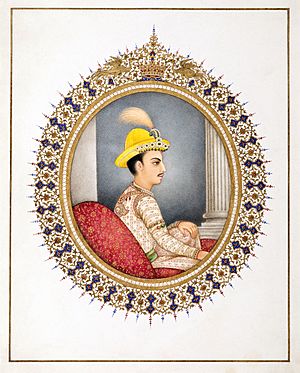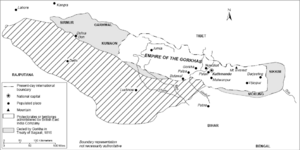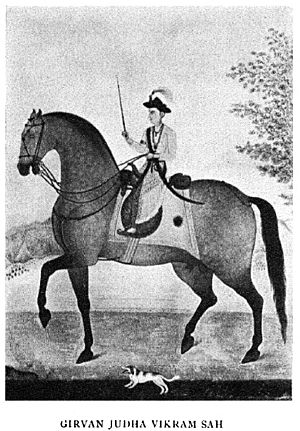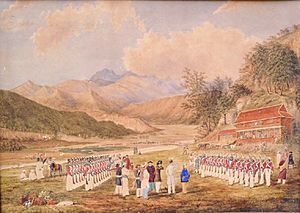Girvan Yuddha Bikram Shah facts for kids
Quick facts for kids Girvan Yuddha Bikram Shah |
|||||
|---|---|---|---|---|---|

Shah, c. 1815
|
|||||
| King of Nepal | |||||
| Reign | 8 March 1799 – 20 November 1816 | ||||
| Coronation | 8 March 1799 | ||||
| Predecessor | Rana Bahadur Shah | ||||
| Successor | Rajendra Bikram Shah | ||||
| Born | 19 October 1797 Basantapur, Nepal |
||||
| Died | 20 November 1816 (aged 19) Basantapur, Nepal |
||||
| Spouse |
|
||||
| Issue |
|
||||
|
|||||
| Dynasty | Shah | ||||
| Father | Rana Bahadur Shah | ||||
| Mother | Karnavati Jha | ||||
| Religion | Hinduism | ||||
Girvan Yuddha Bikram Shah (Nepali: श्री ५ महाराजाधिराज गीर्वाणयुद्ध विक्रम शाह देव) was the fourth King of Nepal. He ruled from 1799 to 1816. He was born on October 19, 1797, and passed away on November 20, 1816.
Girvan Yuddha Bikram Shah became king when he was only about 18 months old. His father, King Rana Bahadur Shah, decided to give up his throne. Girvan Yuddha Bikram Shah ruled with the help of a regent. This meant Queen Tripurasundari of Nepal and Prime Minister Bhimsen Thapa helped him govern. He died at the age of 19. His young son, Rajendra Bikram Shah, then became the new king.
Contents
The Anglo-Nepalese War (1814-1816)
The Gorkha War, also known as the Anglo–Nepalese War, was a big conflict. It happened between 1814 and 1816. The war was fought between the Kingdom of Nepal and the British East India Company. It started because of disagreements over borders. Both sides also wanted to expand their territories.
The British forces attacked Nepal in two main waves. This war was very costly for the British. It ended when the Treaty of Sugauli was signed in 1816. This treaty meant Nepal had to give up about one-third of its land to the British. Much of this land had only been recently taken by Nepal from other kingdoms.
Battle of Nalapani
The Battle of Nalapani was the first major battle of the Anglo-Nepalese War. It took place near Dehradun. The British surrounded the Nalapani fort from October 31 to November 30, 1814. Captain Balbhadra Kunwar led the fort's defenders. He had about 600 soldiers. The British attacking force had more than 3,000 troops.
Major-General Rollo Gillespie led the British. He was killed on the first day of the siege. This happened while he was trying to encourage his soldiers. Despite being greatly outnumbered, Captain Balbhadra and his men held the fort for over a month.
The British tried to attack the fort directly twice, but failed. So, they changed their plan. They cut off the fort's water supply. After three days without water, Captain Balbhadra refused to surrender. He led his 70 remaining soldiers in a brave charge. They fought their way out of the fort and escaped into the hills. This battle showed how tough the Nepalese fighters were.
Battle of Jaithak
Major General Martindale took command of the British forces. He captured the town of Nahan on December 27. Then, he began his attack on the fort of Jaithak. The fort was defended by 2,000 men. They were led by Ranajor Singh Thapa. He was the son of Amar Singh Thapa.
The first British attack failed. The Nepalese successfully defended the fort. The second British attempt managed to cut off the fort's water supply. However, they could not capture the fort itself. This was mainly because the British troops were tired and low on ammunition. Martindale decided to pull back his forces. Jaithak was eventually captured later in the war.
The battle at Jaithak was very costly for the British. They lost over 300 men. After this, Martindale became very cautious. For more than a month, he did not try to attack the Nepalese army again. By mid-February, several British commanders had faced difficulties. This set the stage for Octorloney to take charge and change the war's direction.
The Sugauli Treaty

The Treaty of Sugauli was officially agreed upon on March 4, 1816. According to this treaty, Nepal lost several areas. These included Sikkim (with Darjeeling), Kumaon, Garhwal, and most of the Terai lands. The Mechi River became Nepal's new eastern border. The Mahakali river became the western border.
The British East India Company agreed to pay Nepal 200,000 rupees each year. This was to make up for the lost income from the Terai region. Kathmandu also had to accept a British official called a Resident. However, the rulers of Nepal managed to keep the Resident very isolated. He was almost under house arrest.
The British found it hard to govern the Terai lands. So, some of these lands were given back to Nepal later in 1816. The yearly payments were then stopped. Even after the war, border issues continued for several years. The British did not want to completely destroy Nepal. They saw Nepal as a useful country between them and China.
See also
 In Spanish: Girvan Yuddha de Nepal para niños
In Spanish: Girvan Yuddha de Nepal para niños




